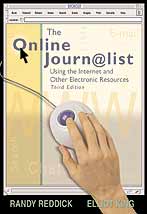 |
 |
 |
 |
![]()
Volume 4,
Issue 2, Winter 2001
|
The Online Journalist: Using the Internet and Other Electronic Resources (3rd ed.) Randy Reddick & Elliot KingHarcourt College Publishers: Fort Worth, TX (2001) 277 pages |

|
Reviewed by: Ronald
Bishop, Drexel
University
For some time, I have been looking for a textbook for our new course in computer-assisted journalism, one that strikes a balance between technical description and information that students can immediately put to us e in doing research for stories. I may have found it in The Online Journalist. Authors Randy Reddick and Elliot King have written a thorough, and for the most part user-friendly guide for students seeking to expand and hone their Internet skills. The book would also be useful for new or mid-career journalists looking for an Internet refresher course.
The book is logically organized, starting with a rich history of the Internet, and a description of how various Internet applications (email, the Web, ftp, usenet, chat) work. One of the book's most effective features is the list of "goals" set by the author for each chapter. This gives the reader a nice road map for the information that follows. The book literally teems with websites that students and journalists can use - I know, since I read most of the book while sitting at a library computer, testing out many of the sites included in the book.
Reddick and King clearly describe each application, then offer detailed evaluations of their strengths and weaknesses as reporting tools. Email, for example, enables reporters to "lay the groundwork" (p. 79) for interviews, and can sometimes be used to coax information from a reluctant source. The authors also masterfully integrate discussions of ethical issues related to net use. For example, they talk about whether journalists should feel comfortable quoting from information gleaned from a chat room.
I have only a few criticisms of the book. First, their description of search strategies was a bit hard to follow, although I must admit to being a neophyte in this area. Second, the book bogs down in the authors' long, but well-written history of the Internet and its various applications. This information is valuable, to be sure, but much of it is well-known, and perhaps not as germane to the day-to-day practice of journalism as the information in later chapters.
Third, while the authors at various points talk about the importance of carefully evaluating sources and information found on the Web, the discussion should be expanded, and perhaps be given its own chapter, with its own supporting examples. My students, even my journalism students, too often accept the Web as gospel. What makes information valid? What makes a web site newsworthy? What makes reporters and editors so willing to pay heed to the Matt Drudges of the world? How do journalists know when they're being taken, or manipulated? Reddick and King urge journalists to learn the difference between sites that offer legitimate journalism and those that offer only advertising and/or promotion (p. 177), but do not talk about why the fuzziness of this boundary is important to the credibility of the craft of journalism. The authors also do not extend the discussion to other kinds of sites.
In the book's first chapter, Reddick and King promise the "assess the impact of the Internet on journalism" (p. 6). While they offer a rich description on how journalists can use the web, their exploration of why journalists (Chapter 12) should use the Internet, and what the potential for overreliance on the net means to journalism falls a bit short. They correctly note that the Internet allows more people to participate in debate on public issues, and that the Internet has opened up a vast range of entrepreneurial possibilities. Yes, the Web "has challenged the hold that large, national media have held on public discussion since the growth of the television networks" (p. 246). But what does the mean for the practice of journalism? Shouldn't trained journalists handle the dissemination of news? In an era when Leonardo DiCaprio is offered up by ABC as a quasi-reporter, a discussion of the ramifications of offering everyone a seat "on the bus" (with apologies to Timothy Crouse) is vital. At best, the Internet is only a complement to on-the-street, knocking on doors reporting.
Even though most college students have a fairly well-developed knowledge of the Internet, perhaps more well-developed than the authors acknowledge, they still need to be sent in the right direction. To that end, future editions of this well-written book would benefit from exercises designed to help students use the vast amount of information the authors offer.
Back to Top
Home | Current
Issue | Archives | Editorial
Information | Search | Interact